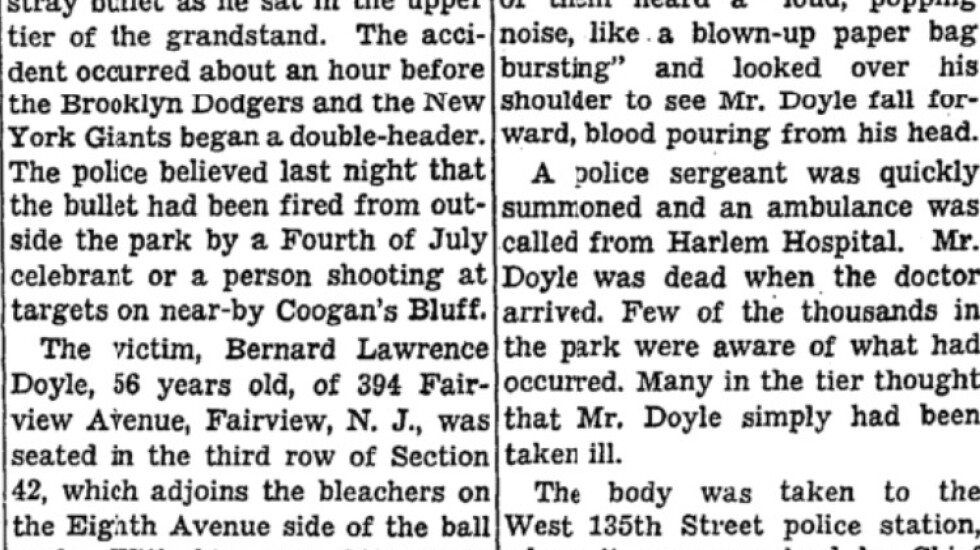
Two fans were somehow wounded by gunfire while sitting in the bleachers at Sox park last week, touching off a media frenzy that has been stoked by the inability of police to determine where the shots came from.
But it isn’t the first time that the stands at a major league ballpark were turned into a crime scene.
At least six other people have been hurt in shootings between 1950 and 2017, including another shooting at a Sox game. In many cases, the circumstances surrounding the shootings are strikingly similar to what happened Aug. 25 at Guaranteed Rate Field.
None of the games were apparently postponed, and the gunshots were mostly pinned on shooters outside the stadiums.
The first known shooting happened on July 4, 1950, shortly before the New York Giants and Brooklyn Dodgers started playing a double-header at the Polo Grounds in Manhattan.
Bernard Doyle, a former freight sorter who managed the heavyweight champion boxer James Braddock, was fatally struck in his head while players were taking the field to warm up.
Most fans didn’t notice that Doyle had been shot, although one spectator reported hearing a “loud popping noise, like a blown-up paper bag bursting,” according to a front page story in The New York Times.

Police thought the gunfire came from outside the ballpark and began gathering evidence and questioning kids from the surrounding area.
Robert Peebles, 14, was taken into custody a day after the shooting, and he later confessed to firing a .45-caliber pistol into the air from the roof of his apartment building — more than a half-mile from where Doyle was struck.
He was ultimately committed to a state boys’ home after police found guns and ammunition in his apartment, according to the Times. But the firearm that killed Doyle wasn’t found, and charges related to his shooting were dropped.
Decades later, Rodolfo Diaz accidentally fired a gun during a Sox home game against the Seattle Mariners on Sept. 29, 1993. He allegedly struck his wife in her legs and grazed his own hand as they sat in the upper deck behind home plate.
He was charged with unlawful use of a weapon and reckless conduct, but it wasn’t immediately known how the case was resolved.
Virginia Olsthoorn was struck in her abdomen and elbow during a game at Kauffman Stadium in Kansas City, Missouri, where the Royals were hosting the Pittsburgh Pirates on June 9, 2010.
A Kansas City police spokesman told reporters that other fans heard a “pop” before she was wounded in the stadium, ESPN reported at the time. A second bullet apparently tore through a seat in the upper deck and landed on the ground, the spokesman said.
Police weren’t immediately able to determine whether the shots came from inside or outside the ballpark, and no arrests have been publicly reported.
Olsthoorn sued the Royals and a state agency in federal court, alleging they allowed someone to enter the ballpark with a gun. A confidential settlement was reached, with the team denying wrongdoing, ESPN reported.
Then on June 16, 2012, a bullet struck Charles Sweatt in his thigh as he was watching the Tampa Bay Rays play the Miami Marlins at Tropicana Field, a domed stadium in St. Petersburg, Florida.
Sweatt, the police chief in Parker, Florida, initially thought he was struck by a foul ball and he was only left with a bruise, according to the Tampa Bay Times.
At the time, police said the bullet could have come from miles away and may have stemmed from a shooting at a park around the same time.
On Friday, a St. Petersburg police spokeswoman said no arrests have been made.
“Officers were unable to determine where the bullet came from or who is responsible for firing the bullet into the air,” said spokeswoman Ashley Limardo.
Five years later, on May 2, 2017, a 34-year-old woman was grazed in her arm while sitting near the dugout at Busch Stadium, where the St. Louis Cardinals were hosting the Milwaukee Brewers.
A fan said no one noticed anything was wrong until security was summoned to help, and police said a bullet was found near her seat, according to USA Today. The team initially said the bullet “presumably originated outside the stadium.”
On Friday, St. Louis Police Sgt. Charles Wall said he wasn’t aware of any arrests being made.
“I do not believe we were able to determine where the bullet came from,” Wall told the Sun-Times. “We do not believe someone purposefully shot into the stadium.”
Fast forward to Chicago, where police are struggling to provide updates on the latest investigation.
Interim Chicago Police Supt. Fred Waller on Monday said investigators had “almost completely dispelled” the possibility that gunfire came from outside the stadium. But on Wednesday, a police spokesperson said “no theories have been ruled out.”
White Sox Chairman Jerry Reinsdorf finally spoke out on Thursday, telling reporters that Waller and other police officials “have not ruled out that the shots came from outside the ballpark.”
“I don’t want to get into specific facts while they’re investigating,” Reinsdorf said, “but we’ve really done a deep dive into this, and I don’t see any way in the world that the shots could have come from inside the ballpark.”







